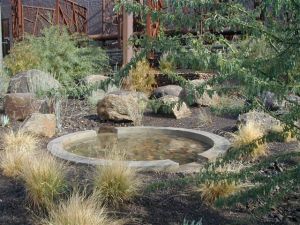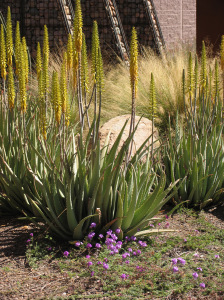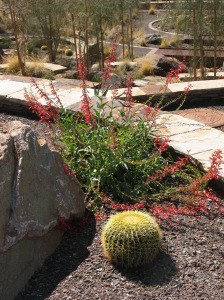 Many of us would like a backyard that provides a little more wow each year without increasing our water use and water bills and, hopefully, even lowering them. Whether you’ve been in the Valley 10 years or 10 months, turning a yard into a shady and showy Sonoran Desert garden takes inspiration and a little know-how.
Many of us would like a backyard that provides a little more wow each year without increasing our water use and water bills and, hopefully, even lowering them. Whether you’ve been in the Valley 10 years or 10 months, turning a yard into a shady and showy Sonoran Desert garden takes inspiration and a little know-how.
Your cities want to help you with both. Here’s why: In the Phoenix area, as much at 50-70 percent of a home’s water use is outdoors. Conservation of water used outdoors is critical in our desert environment. But cities also understand that beautiful landscaping and yards improve a family’s joy in their home, maintain property values, and increase a community’s appeal.
 So, that is why cities invest in demonstration gardens, among other conservation programs, to encourage and teach people to plant beautiful yards that thrive with very little water and maintenance.
So, that is why cities invest in demonstration gardens, among other conservation programs, to encourage and teach people to plant beautiful yards that thrive with very little water and maintenance.
Renowned landscape designer Christine Ten Eyck designed the Scottsdale Xeriscape Garden at Chaparral Park. It covers 5.5 acres and was completed in 2007 on the southeast corner of McDonald and Hayden roads. Scottsdale water conservation specialist Bill Casenhiser lovingly oversees the maintenance of the garden.
The garden can’t be seen from the road but still attracts about 50 to 60 visitors a day. It’s a living lesson about which shrubs and plants thrive in shade, which glow and grow in the sunshine, and how to plant a garden that stays green and blooming all year. The garden is a valuable stop before going to a nursery and being overwhelmed with acres of choices. The Scottsdale Xeriscape Garden offers visitors detailed signs that explain the value of particular plants and how to plant and nurture them.
Scottsdale also offers garden tours led by the garden’s caretaker. Check Scottsdale’s conservation office’s list of workshops and register early to secure a spot. A visit to the Scottsdale garden can help you plan your garden with a purpose:
- Are you looking to reduce maintenance or convert a grassy area into a desert-adapted garden? The solution is not more gravel but choosing plants that fit the space once they are mature. That means they won’t need much trimming. The Scottsdale garden offers examples of the size of trees, shrubs, and plants when mature and how they look grouped and in rows. Did you know there is a large and dramatic prickly pear with very little of the prickly part? The pads on an Indian Fig prickly pear are s
 mooth.
mooth. - Do you want more flowers? Then visit the garden and make a list of trees, plants and shrubs that flower at different times of the year. The Texas Mountain Laurel blooms are large clusters of tiny blue flowers that smell like grapes, some people say wine. It’s blooming now in the garden.
- Do you want to attract wildlife? Scottsdale’s garden is a certified wildlife habitat. You can see trees with limbs conducive to nesting, find plants where butterfly larvae can feed, and watch plants and shrubs with seeds, berries and flowers attract quail and other birds.
The cities of Chandler, Gilbert, Glendale, Mesa, Peoria, and Tempe also have demonstration gardens. They are worth checking out even if you are just looking for a peaceful and beautiful urban setting. Cities also offer free workshops to help with planning, planting, and maintaining a desert yard. It’s planting season, so the workshop calendars are full of events. See if one fits into your schedule.
From time to time, Water – Use It Wisely features guest bloggers who write about topics related to water and water conservation. Kathleen Ferris, the Executive Director of AMWUA, has been involved in Arizona water issues for the past 38 years. She began her career in 1977 working for the Arizona State Senate, and later that year was appointed Executive Director of the Arizona Groundwater Management Study Commission. Her work with Governor Bruce Babbitt culminated in the passage of the 1980 Arizona Groundwater Management Act. Kathy participated in the Act’s negotiations and supervised the drafting of the Act, which continues to be one of the nation’s most visionary laws for managing groundwater. You can view her original blog post on the Arizona Municipal Water Users Association website here.
For 45 years, Arizona Municipal Water Users Association (AMWUA) has worked to protect our member cities’ ability to provide assured, safe and sustainable water supplies to their communities. For more water information visit www.amwua.org.



 mooth.
mooth.